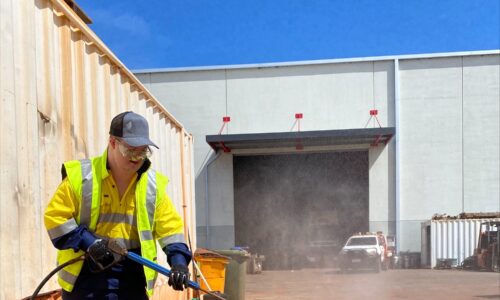What is Reverse Circulation drilling?
Reverse Circulation (RC) drilling is one of the three main types of mineral exploration techniques offered by Ranger. Used to compile sample rock cuttings, the drilling process relies on hollow inner tubes to transport samples back to the surface in a continuous flow, using compressed air. Originally introduced to Australian in the 1970s, RC drilling is a preferred method for initial mineral exploration.
Suitable for diverse terrain, and depths of up to 500-metres, Ranger’s Reverse Circulation setups consists of the rig, a support Truck, Booster, auxiliary compressor truck and a crew vehicle.
How does RC Drilling work?
The on-board compressor delivers power to a pneumatic reciprocating piston. The piston, in turn, drives a tungsten-steel drill bit which is purpose designed to be able to crush hard rock.
Similar to air core drilling, drill cuttings are returned to surface inside rods. We achieve this through the use of dual wall drill rods: an outer drill rod with an inner tube. When compressed air is blown through the rod, the volume displaces the air, lifting the samples to the surface.
Once cuttings reach a diverter at the top of the hole, they’re moved through a hose and around the cyclone, which slows the sample down. From the cyclone the sample goes over a splitter that delivers a percentage of the entire sample into a sample bag. The exploration drilling team then collect the samples aligned to the hole depth and lay them out for the client to log, and then transport to the lab for assay.
What are the benefits of Reverse Circulation drilling?
Versatile across terrains
When compared with diamond drilling, Reverse Circulation drilling uses far less water, making it ideal for remote areas of WA, where sourcing water can drive up the running costs of an operation. Compound this with an average 40% lower operational cost, and it’s a reliable choice for complex and remote locations.
Reliable samples
One benefit of RC drilling is in keeping samples free of cross-contamination. Because the cuttings travel through the inner tube, they aren’t exposed to other areas of the hole. Furthermore, samples are labelled relating to depth and location.
Workforce and time savings
Cover more ground in a day. Combining a rapid method of retrieval of drill cuttings and superior production rates than diamond core drilling, means you get results from RC drilling faster. RC drilling also has a small rig footprint, eliminating the need for extensive earthworks.
Ranger’s Reverse Circulation Drilling
Our team is experienced in drilling all formations, and well-placed to carry out works in brownfields sites and remote exploration work. Our experienced drillers are all qualified with a Certificate III or IV in Mineral Exploration Drilling. Ranger Drilling is accredited against AS/NZS4801, ISO9001 and 14001.

